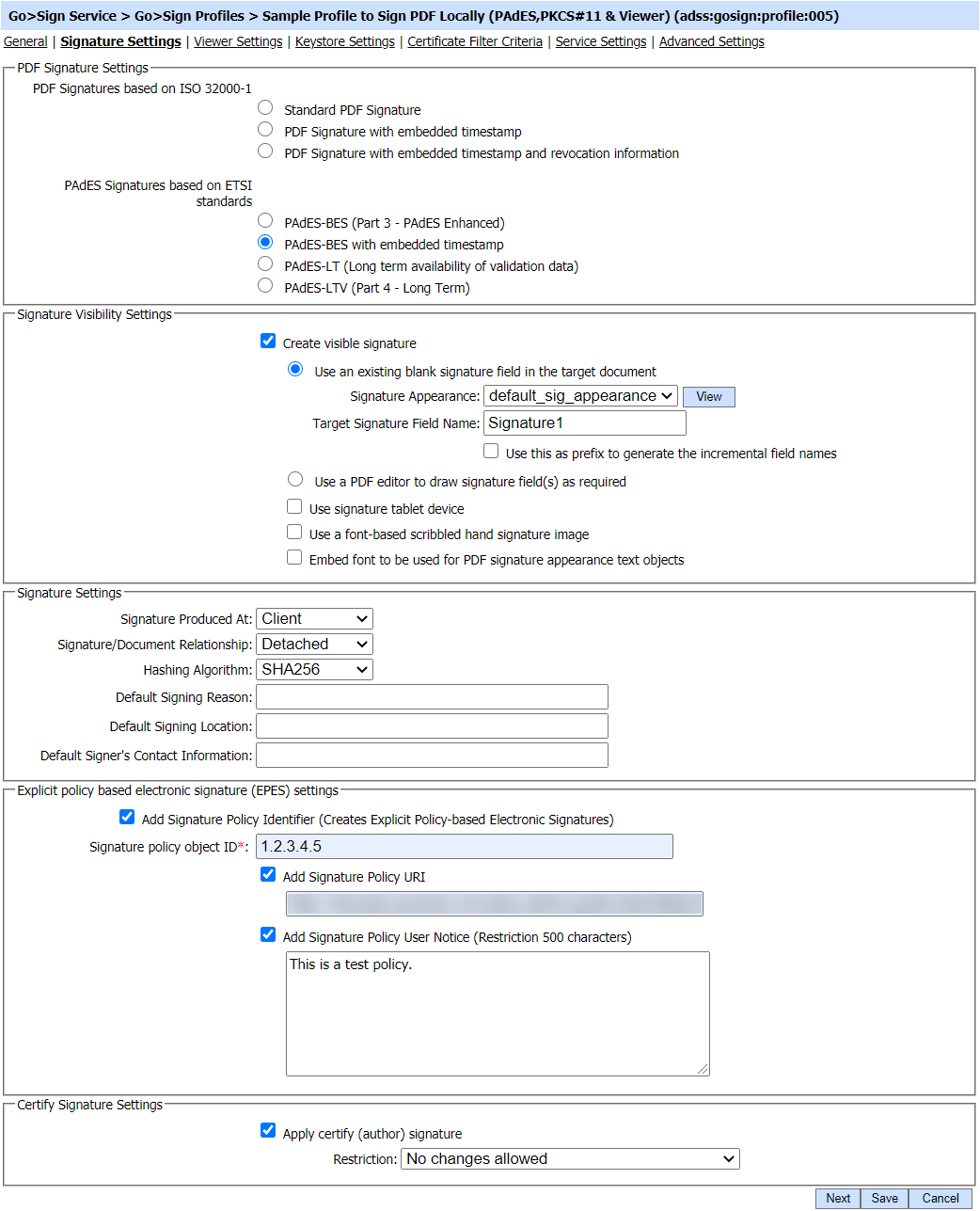PDF/PAdES Signing Attributes
This page is used to configure the PDF/PAdES signature settings that will be used by Go>Sign applet.

The configuration items are as follows:
| Item |
Description |
| PDF Signature Settings |
A mandatory field that selects the type of signature to be produced by this Go>Sign profile. The following types of signatures are supported:
PDF Signature based on ISO 32000-1:
PadES Signature based on ETSI Standards:
Select the signature format to be produced. For more details see the section Supported Signature Types.
|
| Create visible signature |
Check this checkbox if you want to create Visible PDF Signatures. If unchecked then Invisible PDF Signatures will be created. The possible values are:
Signature Appearance Target Signature Field Name Use this prefix to generate the incremental field names
Create empty field signatures using the PDF. Sig Locations. These configurations will then be used while signing the document, ADSS Server Go>Sign Service will create the empty signature fields with field names and the signature appearance allocated to those empty signature fields. Set the PDF Signature Locations settings to create the empty signature fields with names as mentioned and located in the PDF editior. Set the Default Appearance Name which will embed the appearance and signer's details on the signature field when signed. |
| Embed font to be used for PDF signature appearance text objects |
Optionally select the fonts used in the signature appearance to be embedded in the signed PDF document. Using this option, PDF/A compliant documents will retain PDF/A compliancy after signing. Note the following rules:
|
| User signature tablet device |
Enable this checkbox if you want to place the hand signature image for visible PDF signatures using signature tablet device.
Note: Only Wacom and Signotec tablet devices are supported yet.
|
| Use a font-based hand signature image |
Go>Sign Service uses these configuration to create hand signature image for the signer in case of visible signature. This option will be available only when document viewer is marked disabled |
| Signature Produced At |
This defines where the signature will be produced. Possible values are:
|
| Signature/Document Relationship |
This defines how the signature and document exist i.e. one inside the other or do they exist separately. Following options are supported for PDF signatures:
Note: In case of remote signing the "Signature/Document Relationship" selected in the Go>Sign Service and the Signing Service should be same i.e. if the option selected in the Go>Sign profile is "Enveloping" then the same should be configured in the Signing profile as well. The same goes for the "Detached" signatures.
|
| Hashing Algorithm |
The selected hashing algorithm is used as part of the signature generation process. Following hashing algorithms are supported:
Note: In case of remote signing the "Hashing Algorithm" selected in the Go>Sign Service and the Signing Service should be same i.e. if the option selected in the Go>Sign profile is "SHA256" then the same should be configured in the Signing profile as well.
|
| Default signing reason | This defines the default signing reason that should be shown on the signature dialogue during the signing operation. |
| Default signing location | This defines the default signing location that should be shown on the signature dialogue during the signing operation. |
| Default signer's contact information | This defines the default signer's contact information that should be shown on the signature dialogue during the signing operation. |
| EPES Signatures |
Explicit Policy Based Electronic (EPES) signature settings are only available for the PAdES Signature types. By enabling the check box Add Signature Policy Identifier, the Go>Sign profile can be used to produce (EPES) signatures where a signature policy OID, URI and user notice are added in the digital signature as specified below.
|
| Apply certify (author) signature |
Allows you to certify+sign the document and select one of the following document protection options:
Note: If the document to be signed already has a certify signature on it then this would normally lead to an error. This option is intelligent and ignores the request for a "certify" type of signature a standard signature is applied instead. This means that one profile can be used to sign a document multiple times - the first will be certify signed and the other signatures will be standard signatures.
|
Clicking the Next button will display the Viewer Settings page.
See also